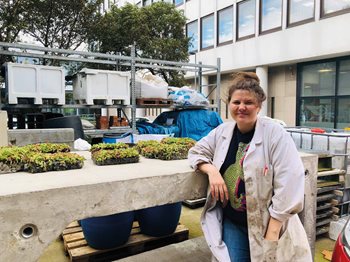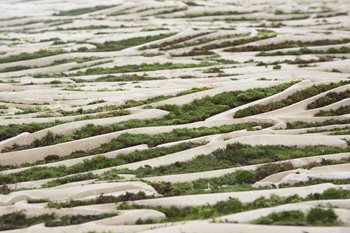Bioreceptive concrete
Beyond biodiversity, nature in cities can also help to mitigate air pollution, overheating and flooding as well as improve psychological wellbeing. Concrete can support plant and animal life in surprising and often beautiful ways. Researchers are using it as durable substrate, robust shelter, even a source of nutrients for many different creatures from the smallest to the most useful to the most endangered.
Biocrete
This innovative concrete, has been developed to be hyper-porous - holding water like a sponge. The concrete comprises 90% recycled material as well as nutrients for the plants that it supports.

Material Evolution, is developing plant-friendly concrete panels, known as 'biocrete' with an open cell structure to allow for plant and water ingression while providing protection for waterproof membranes and insulation behind
The panels have deep indents in which plants can take root. Recycled elastic fibres in the mix help the concrete cross-knit back together if it starts to crack under the influence of roots.
Test panels at Queen's University, Belfast are performing well: "The bees, butterflies and other bugs love it and we have measured local improvements in air quality of up to 60%.'
Read more about this innovation in the latest issue of Concrete Futures Magazine
Photo Biocrete sample courtesy of Material Evolution
Photo Dr. Elizabeth Gilligan, founder of Material Evolution
Poikilohydric Living Walls
This bioreceptive concrete is specially designed to encourage the growth of cryptogams, poikilohydric organisms such as moss, algae and lichens, with the capacity to tolerate dehydration and therefore requiring no irrigation.

The surface can either be ‘seeded’ with spores or receive transplanted growth. The plants absorb CO2 and are effective air purifiers, trapping pollution particles.
They also provide a habitat for micro fauna and small insects on which birds can feed.
Part of a prototype façade panel using GRC, lightweight porous concrete and applied moss. Panels are due to be installed at a school and an underground station soon.
Read more about this innovation in the latest issue of Concrete Futures Magazine
Photo Image courtesy of Professor Marcos Cruz, Bio-ID, Bartlett School of Architecture and Pennine Stone Ltd.